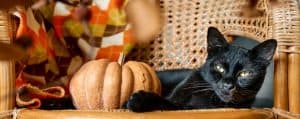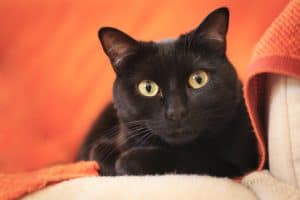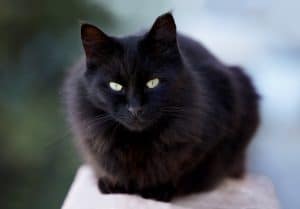
Wait, black cats bring GOOD luck?
Here’s the scoop on how our dark friends got a bad rap—then we flip the script
This time of year, black cats peer out at us from Halloween decorations among witches, monsters and ghouls. Sleek and stunning, false beliefs have given black kitties a bad rap. But that wasn’t always the case—and in some parts of the world, people believe black cats bring good luck, not bad.
How black cats got a bad reputation
You can trace the origins of that frightening black cat Halloween lawn inflatable all the way back to the year 1233. Around that time, the Christian church in Europe began feeling threatened by other religions—and other ways of thinking that conflicted with its teachings. Pope Gregory IX issued an edict called “Vox in Rama,” declaring black cats incarnations of Satan.

Why target Europe’s poor black cats? The cats were already associated with witches, who did not (yet) have negative reputations. They were simply viewed as part of society: women with deep respect for the natural world and its powers, including the healing properties of plants. But as the church grew in power, its leaders saw witches as threats and began persecuting them. They began to spread the belief that witches, independent women who refused to bow to the church, were dangerous. They killed tens of thousands. Church leaders also targeted witches’ cats, who, being cats, were also independent thinkers who did their own thing and were not fans of authority, religious or otherwise. The Church did not tolerate independent women or felines.
Vox in Rama was not only bad news for cats. The document kicked off the Inquisition—200 years of persecution and torture of Jews and Muslims. Adding to cats’ troubles, the felines were blamed for spreading the plague in the 1300s. Ironically, after Europeans exterminated massive numbers of cats, the population of rats—the species that truly did spread the disease—exploded, killing 25 million people.
The Church’s persecution of witches—and their cats—crossed the Atlantic, and the centuries. During the Salem Witch Trials in the 17th century, religious leaders accused and killed women of doing “the devil’s work.” The men in charge considered the women’s black cats to be their “familiars,” or, helpers. They burned them to death as well.
Revered before they were reviled 
Long before religious leaders began coloring black cats as evil, black cats were exalted. Ancient Egyptians held them in the highest esteem because they resembled the black cat-headed goddess Bastet, the goddess of home, fertility and protection from disease. They believed black cats kept evil spirits, as well as disease. Agrarian Egyptians were big fans of all cats, due to the predators’ fantastic pest control capabilities.
In Norse mythology, two black cats pull the chariot of Freya, the goddess of love, fertility and beauty. To win her favor, farmers would leave bowls of milk for them in their fields so they would be blessed with a good harvest.
Positive superstitions around black cats live on today. In the U.K., they’re considered lucky. In parts of England, if a bride receives a black cat as a wedding gift, it’s believed she will have luck in her marriage. In Scotland, a black cat at your door or on your porch is thought to signal prosperity. Sailors across Europe believed they were safer with a black cat or two on board (the animals brought luck and stopped vermin from eating their food). In Japan, spotting a black cat means you’ll have luck finding love.
At KONG we celebrate the independent spirit that brought cats trouble in the past. That’s why we design toys to delight and satisfy cats’ unique instincts, like interactive teasers, mentally stimulating puzzle toys, snuggly cuddle toys, and dynamic, multi-faceted toys designed for solo play to keep independent thinkers healthy and happy.
 from KONG Company
from KONG Company



